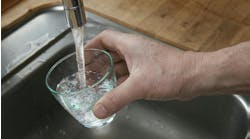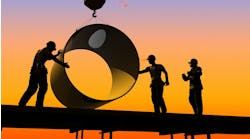CONTRACTOR Publisher and Editorial Director Bob Miodonski and Plumbing Columnist Dave Yates both attended the ISH show in March in Frankfurt, Germany. Miodonski attended the show with a group of Americans and Canadians sponsored by Viessmann Co. Yates traveled with a group sponsored by the National Association of Oil Heat Service Managers.
Click here to read part 1 by Bob Miodonski.
By Dave Yates
Special to CONTRACTOR
I have to confess that my trip to ISH, while much anticipated for several years, was not without a twinge of apprehension. Not only were we at war in Iraq, but Germany was looking all too much like a country not exactly favorable in which to be an American tourist. I was hoping my antique recollection of high school level German classes would return to memory after 33 years.
Then came the newly discovered SARS disease and it didn’t help matters that I was flying Singapore Air, the very same airline that had seen one of its jets quarantined just a week prior to our departure! Our group, led by Judy Garber of NAOHSM, included many good friends and others soon to be held in the same esteem.
After traveling along the River Main that runs through Frankfurt, we found ourselves traveling along Messe Frankfurt, the set of buildings that houses ISH, the flagship of the International Sanitation, Heating and (new) Air Conditioning sectors. The sheer size of the buildings and vast area they encompass was mind-boggling.
Communicating pumps, boilers, controls, testing instruments and plumbing fixtures all point to the coming trend in the trades that will give those who keep abreast of changes ahead of the competition. Style, grace and understated elegance were ever-present in the design of products, and every booth display somehow seemed more amazing than the next. It took me four days to walk through each of the halls in an attempt to see all there was to see at ISH.
Mastering fire
“Mastering Fire” was the theme of Viessmann’s booth, which was the first trade show space we encountered upon entering Hall 8 at ISH. I don’t know if you would actually call it a “booth.” Two stories tall in places, the Viessmann booth measured 100 ft. by 400 ft. Both of the second floors housed restaurants. A waterfall with assorted stainless steel boiler heat exchangers and parts drew attention on their side aisle. The sheer spectacle that was unfolding before my very eyes was an overwhelming sensory experience.
The Buderus booth, another two-story construction with restaurant on the upper floor, took up an entire corner of the hall. A bar serving beer, soda and wine was tucked away under the balcony in the corner and was a very popular spot. The Buderus sales force was ever present and quite popular too — they held the drink tickets that allowed one to quaff a beer.
Everywhere we went in Hall 8, we could view and inquire about condensing boiler technology. Fortunately, almost everyone encountered spoke English.
Jeff Alexander of Peerless boilers was in the NAOHSM group. Peerless sells a condensing boiler called the Pinnacle, and I wanted to hear Jeff’s opinions about the Europeans’ solid commitment to condensing technology. He told me that he felt as if he’d seen the future of the U.S. boiler market and that condensing technology is here to stay.
We were both impressed with technology that will permit boilers to operate well above 100% efficiencies! Although that sounds crazy, it was explained to us that this boost beyond 100% is achievable by extracting the Btu contained in the condensate after leaving the combustion chamber.
Leaving Hall 8, we ventured into building 10, which housed three floors of controls, valves and manifolds. One booth in particular captivated our attention with a number of brainteaser displays such as perpetual-motion machines, a hammer that seemed to be possessed by mythical energy and an oil bottle that never stopped flowing while suspended in thin air.
It was the booth of Danfoss, masters of seemingly magical controls. On display was Danfoss’ ECL control, which can perform any manner of control options and is easily programmed by inserting a memory card into its slot. I’m looking forward to seeing that in the USA.
I encountered a number of companies that specialize in protecting potable water from Legionella bacteria. When I detailed the notion of utilizing potable water heaters for both heating and bathing without some type of physical barrier between the hydronic and potable fluids, the booth personnel gave me a very odd look. I convinced them that I did not practice anything like that and only then would they continue discussing the issues. They take their potable water protection much more seriously than we do here in the United States.
Solar and piping
Seemingly around every corner there was another booth selling solar panels, storage systems and electrical controls. The styles of panels didn’t deviate much from what we’d seen at Viessmann, but one in particular caught my attention. Its panels were built into the side of homes. My impression had always been that solar panels needed to be mounted so they faced the sun’s rays as directly as possible. Clearly this installation defied that notion.
Yes, performance suffered by about 30%. But that’s during the summer months when heat is not necessary and hot water demands are less due to higher incoming service-line temperatures. From December through April, the panel’s performance improves by as much as 50% due to the sun being lower on the horizon. In addition, vertically installed panels last much longer, don’t affect the roof loading and aren’t subject to damage from hail.
Piping systems joined by any means other than solder or brazing were in abundance. Not just for small diameter piping but also for any size you can imagine! Gleaming displays of brightly shined copper tubing were accentuated by studio lighting. These pipes won’t be concealed beneath floors or behind walls - they are works of art proudly showing off their highly reflective patina.
While copper surely stood out as the most attractive, there was no shortage of pressed-on fittings for stainless steel, steel and all manner of plastic tubing. Labor savings compounded like an accountant’s double declining balance sheet calculation as sizes increased. Imagine performing leak-tight joints in 4-in. copper piping in less than two minutes consistently.
Ridgid’s booth was a welcome sight, and we were treated as friends by the young men who were pleased to demonstrate their Pro-Press system. Heat fusion of plastic piping continues to hold its own, and PEX tubing was in great abundance with as many fitting configurations as you can possibly imagine.
Small bathroom solution
If necessity is the mother of invention, then I’ve seen the answer she came up with for small bathroom spaces! While touring the two floors of the Masco Center building, I came across a very intriguing display by the E. Missel Gmbh & Co. Ralf Hummel, Missel’s booth representative, told me that 60% of bathrooms in Germany are between 43 and 53 sq. ft. I’d seen bathing modules bigger than that in virtually every plumbing display, so it was refreshing to delve into a dose of reality.
What caught my eye were the seemingly modular triangular towers designed to support a sink or water closet while concealing the piping. The beauty of this amazingly simple approach allows the contractor the ability to install the fixtures in the corners or side-by-side by placing joining triangular towers together; this creates a flat surface mating along the rear.
With our new plumbing codes allowing installations such as this if the piping is oversized, thereby avoiding siphonage because the line can’t be flooded, these systems have the potential to be hugely popular in the United States. The towers themselves can be purchased with pre-cut panels of hardwood, solid-surface materials such as granite or colored glass panels that can be backlit for a soft glow.
A new bathroom literally can be installed in a matter of hours without cutting into a single wall. Simply drill the drainage and water line holes through the floor, bolt up the towers, connect the lines, install the decorative panels and set the fixtures.
During my conversation with Ralf, he told me that all the products on display within the Masco Center were going to be available in the United States, including the Missel product line.
The Grundfos booth not only greeted visitors with a modernistic waterfall, it had a river running right through the center.
Grundfos has a new pump series that adjusts itself to your piping and system head characteristics. Not only does it adjust itself to run at the most energy efficient point in its pump curve, it can be connected to a phone line for remote monitoring. If it senses a problem, it can call you up and communicate what’s wrong. Access codes ensure secure communication. Then again, if your customer is a bit slow in paying his bill, you could turn off his heat for a while.

